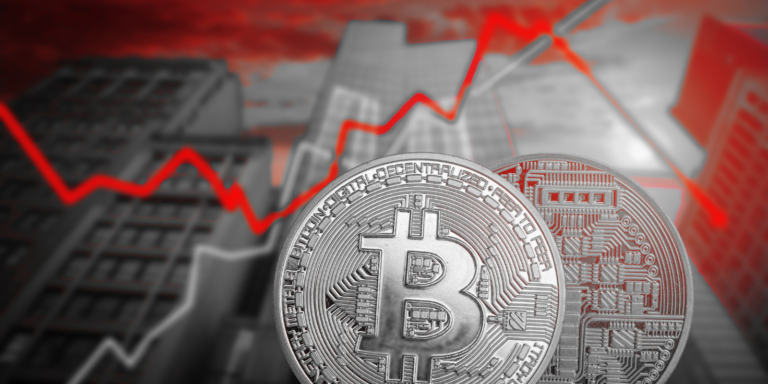Table of Contents
ToggleCryptocurrency prices are highly volatile and can change rapidly. The volatility provides opportunities for traders, with a certain level of risk. In this blog post, we will discuss the different crypto volatility components. We will also examine how you can protect yourself against price fluctuations in the crypto market.
Overview of cryptocurrency
Cryptocurrency has been gaining significant traction in the world of finance. Cryptocurrency is a digital or virtual form of money, secured by encryption and safeguarding it from being faked. Every transaction made with crypto is recorded on the public ledger for complete transparency when sending and receiving payments. This makes cryptocurrency virtually theft-proof due to its limited production capabilities.

What is Volatility?
Volatility is a metric that quantifies the fluctuation of an asset’s price. Consequently, it is used to measure market risk and as an aid in financial analytics. Although it can be considered an abstract concept, volatility is an important factor in understanding market movements and their potential for large returns or losses. Understanding volatility is an essential skill for all investors, as it can be used to identify suitable assets for portfolio diversification, receive prior warning of an impending correction or bear market, and determine appropriate entry and exit points.
Volatility in the Crypto Market
The crypto market is famously volatile, with prices taking sharp up-and-down swings that can be exciting for experienced traders but daunting for beginners. Such quick price fluctuations have attracted a great deal of attention, both positive and negative, but regardless of perspective, they signify an attractive investment opportunity. Those who are prepared to invest cautiously and keep a close eye on the market will find themselves at an advantage, whilst those who take a chance may emerge with significant returns.
Short term volatility
Short-term volatility is the fluctuation of an asset’s price within a short amount of time – usually days, weeks, or even a few months. For example, if you buy Bitcoin in Dubai or any other part of the world and sell it on the next day or after a week, short-term volatility can bother you. It is the opposite of long-term investing. Volatility can be exciting for traders who seek to capitalize on the movements in the markets, making it possible to take advantage of price disparities that could arise suddenly.
On the other hand, low volatility can indicate greater stability but less opportunity for arbitrage or trading profits. Short-term volatility also plays an important role when discussing risk and reward as well as expected returns from investments which might be subjected to a different degree of volatility than other financial instruments.
Long term volatility
Long-term volatility is an important metric for anyone in the financial industry, as it is a way to measure fluctuations of investments over a period of time. When you buy cryptocurrency to hold for a long period of time, your concern is with long-term volatility now. It is the concept that investments or returns are not consistent and that their values can vary significantly over time.
To define this, long-term volatility displays changes in the value of an asset or security relative to its initial purchase price over 6 months or more – often used in ratio form to indicate risk or variation in securities. Long-term volatility can be used as a reliable barometer for evaluating investment strategy and performance since it primarily reflects market sentiments and forces such as consumer demand at large sectoral levels.
Crypto volatility comparison
There is no denying the significant volatility of cryptocurrencies in comparison to traditional assets and currencies. While this can be a major source of concern for investors, online traders, and even governments, understanding how to anticipate and navigate market swings can help maximize potential profits over the long term. Of course, crypto trading involves high risk and no guarantees, but that doesn’t have to deter potential traders.
By keeping an eye on fluctuations of different digital currencies with respect to their peers and related news developments, it is possible to make well-informed decisions with regard to entering and exiting the markets. With a bit of patience, research, and a skillful trading strategy, crypto volatility can become an asset rather than an obstacle.
Crypto Volatility Components
1. Lack of Regulation
One of the primary factors that contribute to the volatility of cryptocurrencies is the lack of regulation in the space. Cryptocurrencies are not subject to the same rules and regulations as traditional financial assets, which makes them more susceptible to manipulation and fraud. Additionally, there is no central authority that oversees the cryptocurrency market, which can make it difficult to resolve disputes or investigate wrongdoing.
2. Limited Acceptance
Another factor that contributes to cryptocurrency volatility is limited acceptance. While some businesses have begun to accept cryptocurrencies as payment, they are still not widely accepted as a form of payment. This limited acceptance means that there are fewer opportunities to use cryptocurrencies to purchase goods and services, which can make them more volatile.
3. Volatile Price
The price of cryptocurrencies is also highly volatile, which can contribute to their overall volatility. Cryptocurrency prices are often driven by speculation, as investors buy up coins in hopes of selling them at a higher price in the future. This speculation can lead to rapid price swings, as investors sell off their coins when prices fall.
4. Lack of Understanding
Many people do not understand how cryptocurrencies work, which can contribute to their volatility. Cryptocurrencies are a new and complex asset class, and it can be difficult for even experienced investors to understand how they work. This lack of understanding can lead to panic selling when prices start to drop, as investors do not trust that they will be able to recoup their losses.
5. Hacking Attacks
Hacking attacks are another factor that can contribute to cryptocurrency volatility. Due to the decentralized nature of cryptocurrencies, they are often stored in online wallets that are vulnerable to hacking attacks and many cases of crypto scams have been seen. If hackers are able to gain access to these wallets, they can steal the coins stored within them, which can cause the price of the currency to drop sharply.

6. Fraudulent Activities
Fraudulent activities are also a major factor in cryptocurrency volatility. There have been numerous instances of people creating fake cryptocurrencies or exchange platforms in order to defraud investors. These fraudulent activities can cause the price of a currency to drop sharply as people lose confidence in the space.
7 . Geopolitical unrest
Geopolitical unrest is another factor that contributes to cryptocurrency volatility. For example, if there is a war or other conflict in a country where Bitcoin is popular, this could lead to people selling off their Bitcoin holdings in order to protect their wealth. As was seen during the Ukraine and Russia conflict when a large number of people sell Bitcoin in Dubai for cash due to the unrest geopolitical situation. This could cause the price of Bitcoin to drop sharply in the affected region.
Tips to earn from crypto volatility
1. Do your research
Before investing in any cryptocurrency, it’s important to do your research. There are a lot of different factors that can affect the price of a cryptocurrency, and it’s important to understand as many of them as possible before investing. Some things you should research include the technology behind the cryptocurrency, the team behind the project, and the overall market conditions.
2. Buy low, sell high
One of the most important things to remember when trading cryptocurrencies is to buy low and sell high. This may seem like common sense, but it’s often easier said than done. In order to make a profit, you need to buy a currency when its price is low and sell it when its price increases.
3. Use stop-loss orders
A stop-loss order is an order that automatically sells your position when the price reaches a certain level. Stop-loss orders can help you limit your losses if the price of a currency goes down.
4. Use limit orders
A limit order is an order that automatically buys or sells your position when the price reaches a certain level. Limit orders can help you lock in profits if the price of a currency goes up.
5. Be patient
Cryptocurrencies can be very volatile, and prices can change rapidly. It’s important to be patient when trading cryptocurrencies and to only make trades when you’re confident in them. Trying to time the market is often a losing proposition, so it’s better to wait for good opportunities rather than trying to force them.
6. Don’t invest more than you can afford to lose
Cryptocurrencies are a risky investment, and there’s always the potential of losing money. It’s important not to invest more money than you can afford to lose so that you don’t find yourself in financial trouble if the market takes a turn for the worse.
7. Diversify your portfolio
Investing in multiple cryptocurrencies can help you diversify your risk and protect your portfolio from losses if one particular currency goes down in value.
FAQs
What determines volatility in crypto?
Volatility in crypto is primarily determined by supply and demand. When there is more demand than supply, prices go up. When there is more supply than demand, prices go down.
Other factors that can contribute to volatility include news events, regulatory changes, and sentiment. For example, when a negative news event happens, it can cause people to sell their coins, increasing volatility. Alternatively, when positive news happens, it can cause people to buy coins, which will then decrease the volatility.
How can you manage crypto volatility?
Volatility is an inherent characteristic of cryptocurrencies and there is no way to completely avoid it. However, there are a few things that can be done to help manage it:
1) Diversify your portfolio:
Don’t put all your eggs in one basket. Invest in a variety of different cryptocurrencies to help spread out your risk.
2) Hold onto coins for the long term:
Over time, prices have tended to go up so if you can hold on for a while, you may end up making a profit.
What is a good measure of volatility in crypto?
A good measure of volatility in crypto is the standard deviation of returns. The standard deviation is a statistical measure of the variability or dispersion of a set of data points. It can be used to calculate the risk associated with an investment. A high standard deviation means that the returns on the investment are highly variable and that there is a high degree of risk associated with investing in it.
What causes high volatility in crypto?
There are a few key reasons for the high volatility in crypto:
1. Lack of regulation and oversight:
Since crypto is a relatively new technology, there is no clear regulatory framework guiding its use and trading. This lack of regulation leaves the door open for speculation and price manipulation.
2. Extreme price swings:
The prices of many cryptocurrencies can swing wildly from day to day or even hour to hour, contributing to high volatility.
3. Limited liquidity:
With relatively few people currently investing in crypto, there is limited liquidity in the market, which can amplify price swings.
4. inexperience of investors:
Many investors are new to crypto and may not have a good understanding of how it works or what drives prices up and
What are the most volatile hours in crypto?
The most volatile hours in crypto trading are usually between the hours of 7 am and 11 am EST. This is when the Asian markets are open, and there is usually a lot of volatility as traders make their moves before the European markets open.
What time of day does crypto peak?
Cryptocurrencies are traded around the world 24/7, so there is no specific time of day that they peak. However, there are certain times of day when trading volumes are higher than others. For example, trade volume tends to be highest during the Asian and European trading sessions, and lowest during the American trading session.
Final thoughts
Though cryptocurrencies are highly volatile, that doesn’t mean you can’t make money off of them. You just need to be careful about the risks you take and make sure that you can afford to lose the money you put in. Cryptocurrencies are incredibly volatile, and their prices can change drastically in a matter of minutes or hours. This makes them a high-risk investment, but it also means that they have the potential to generate huge profits if you buy and sell at the right times.
However, it’s important to remember that you should never invest more money than you can afford to lose. Cryptocurrencies are incredibly volatile, and there is no guarantee that they will rise in value. So make sure you only invest money so that you’re prepared to lose it.





